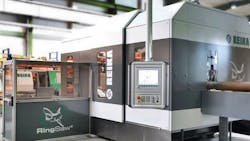GRAEBENER-REIKA INC., suppliers of machinery for processing tube, pipe, bar, plate and sheet metal, now updates the cold saw cutting process with its new RingSaw line for high-strength materials, including oil country tubular goods and other demanding applications. Instead of cutting with the outside diameter of the blade, RingSaw puts teeth in the enlarged center hole which, when compared to conventional carbide saws, changes and improves the dynamics that affect cost and quality of finished pieces.
RingSaw machines rotate the blade by turning the outside diameter and the enlarged center hole is for cutting instead of the traditional spindle design. This innovation leads to 50-80% a reduction in tool costs, while at the same time increasing performance by 30-60%.
“We are talking about six-figure amounts that can be saved each year,” according to Rich Marando, president of Graebener-Reika. “One of our customers, a manufacturer of rolling bearing rings, confirmed these savings using RingSaw to cut bearing blanks of material grade 100Cr6, pre-hardened, diameter of 73 mm, and a wall thickness of 12.6 mm.”
One way the RingSaw achieves superior performance over conventional blades is in better chip management. It uses milling-type carbide inserts that take a greater bite than regular cold saw blades. This increases material removal rates and results in larger chips that are easier to recover and do not stick to the machine’s sides, thus improving maintenance characteristics.
Although teeth on a RingSaw are more substantial than traditional cutting blades, they are also more versatile. The teeth are mounted with machined seats and screws rather than soldered to the blade. When an edge becomes dull, an operator rotates the insert to one of four fresh edges and the insert is replaced after all four edges have been used.
Additionally, the teeth are tapered into contact with the workpiece gently, nearly eliminating burrs, which contributes to cost savings in the finishing stages.
Every RingSaw machine is equipped to support wet or dry cutting, integral cutting fluid, and chip management systems. Cost benefits and cycle time gains are substantial for pipes and couplings. Rounds, shapes, hollows and solids are easily accommodated.
The RingSaw design was pioneered from the “whirling machine” concept developed by Procon, which was acquired by Reika in 2009. Engineering from the Graebener Group brought the RingSaw design to commercial availability. The machine works by feeding a workpiece along the X-axis through the hole in the blade’s center, and the blade oscillates on a Y-Z slide table to make the cut.
Visit www.gr-inc.com
